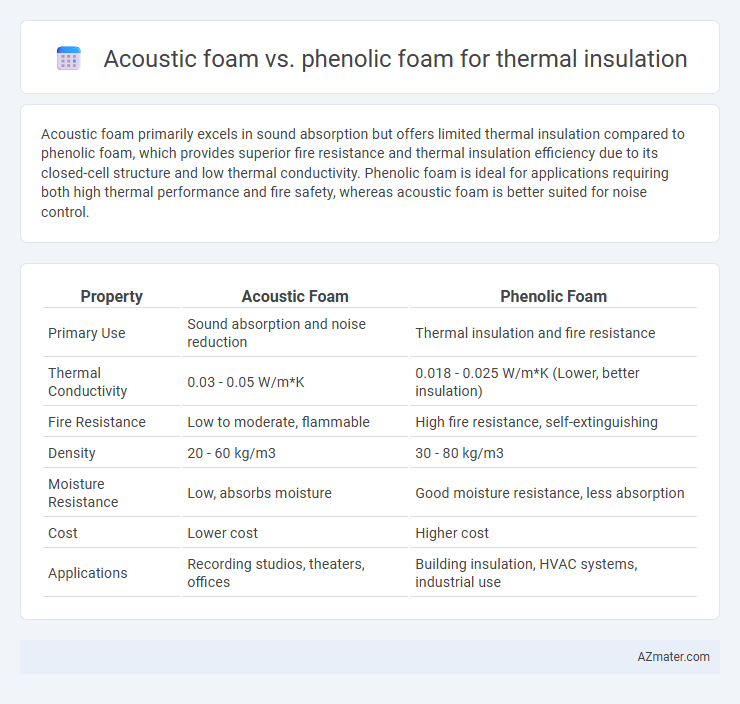Acoustic foam primarily excels in sound absorption but offers limited thermal insulation compared to phenolic foam, which provides superior fire resistance and thermal insulation efficiency due to its closed-cell structure and low thermal conductivity. Phenolic foam is ideal for applications requiring both high thermal performance and fire safety, whereas acoustic foam is better suited for noise control.
Table of Comparison
| Property | Acoustic Foam | Phenolic Foam |
|---|---|---|
| Primary Use | Sound absorption and noise reduction | Thermal insulation and fire resistance |
| Thermal Conductivity | 0.03 - 0.05 W/m*K | 0.018 - 0.025 W/m*K (Lower, better insulation) |
| Fire Resistance | Low to moderate, flammable | High fire resistance, self-extinguishing |
| Density | 20 - 60 kg/m3 | 30 - 80 kg/m3 |
| Moisture Resistance | Low, absorbs moisture | Good moisture resistance, less absorption |
| Cost | Lower cost | Higher cost |
| Applications | Recording studios, theaters, offices | Building insulation, HVAC systems, industrial use |
Introduction to Acoustic Foam and Phenolic Foam
Acoustic foam primarily consists of open-cell polyurethane designed to absorb sound waves and reduce noise levels, offering limited thermal insulation properties. Phenolic foam, a rigid cellular plastic made from phenol-formaldehyde resin, provides excellent thermal insulation due to its low thermal conductivity and high fire resistance. Both materials are utilized in building applications, but phenolic foam is favored where superior thermal performance and fire safety are critical.
Composition and Material Properties
Acoustic foam, typically made from open-cell polyurethane or melamine resin, is designed primarily for sound absorption, featuring low density and high porosity that enhances acoustic dampening but limits thermal insulation effectiveness. Phenolic foam, composed of phenol-formaldehyde resin, exhibits a closed-cell structure with low thermal conductivity, superior fire resistance, and excellent dimensional stability, making it highly efficient for thermal insulation applications. The inherent material properties of phenolic foam, including high thermal resistance and low smoke emission, contrast with acoustic foam's porous nature, which compromises its thermal insulating performance.
Thermal Insulation Performance
Phenolic foam exhibits superior thermal insulation performance compared to acoustic foam due to its low thermal conductivity, typically around 0.02 W/m*K, which enhances energy efficiency in building applications. Acoustic foam primarily focuses on sound absorption and generally has higher thermal conductivity values, making it less effective for thermal insulation purposes. Phenolic foam's closed-cell structure provides enhanced thermal resistance and fire retardancy, making it a preferred choice for thermal management in industrial and construction sectors.
Acoustic Insulation Capabilities
Acoustic foam primarily excels in sound absorption, reducing echo and reverberation, making it ideal for acoustic insulation in studios and auditoriums. Phenolic foam, while primarily designed for thermal insulation due to its low thermal conductivity and high fire resistance, offers limited acoustic damping properties compared to specialized acoustic foams. For applications prioritizing noise control, acoustic foam provides superior sound insulation capabilities, whereas phenolic foam serves best where thermal performance is required alongside basic sound attenuation.
Fire Resistance and Safety Ratings
Phenolic foam offers superior fire resistance compared to acoustic foam, with a higher limited flame spread index and lower smoke development rating, making it ideal for stringent fire safety standards in thermal insulation applications. Acoustic foam typically exhibits lower fire retardancy, often classified as combustible or with higher smoke emissions, which can pose increased safety risks in building environments. Selecting phenolic foam enhances safety by meeting rigorous fire codes, reducing fire hazards, and ensuring compliance with fire resistance regulations in thermal insulation solutions.
Installation Methods and Ease of Use
Phenolic foam offers straightforward installation due to its rigid board form, allowing easy cutting and fitting with common tools, while providing excellent thermal insulating properties. Acoustic foam, typically softer and more flexible, requires adhesive or mechanical fasteners for installation, which can be more time-consuming and less precise for thermal insulation applications. Phenolic foam's lightweight nature and dimensional stability enhance ease of use in both residential and commercial thermal insulation projects.
Durability and Lifespan Comparison
Phenolic foam offers superior durability and a longer lifespan compared to acoustic foam due to its rigid cellular structure and resistance to moisture, chemicals, and fire. Acoustic foam, while effective for sound absorption, typically degrades faster when exposed to environmental factors such as humidity and UV light. Phenolic foam maintains thermal insulation performance over decades, making it a more reliable choice for long-term applications requiring robust durability.
Environmental Impact and Sustainability
Acoustic foam, typically made from polyurethane, has limited biodegradability and often relies on petroleum-based materials, resulting in higher environmental impact compared to phenolic foam. Phenolic foam, derived from phenol-formaldehyde resin, offers superior fire resistance and lower smoke emissions while being more recyclable and less toxic during production. Sustainable insulation choices favor phenolic foam due to its longevity, reduced volatility organic compound (VOC) emissions, and potential for reuse in circular building practices.
Cost Analysis and Budget Considerations
Phenolic foam generally offers superior thermal insulation performance at a higher initial cost compared to acoustic foam, which is typically less expensive but primarily designed for sound absorption. Budget considerations favor phenolic foam in long-term projects due to its durability and lower thermal conductivity, resulting in energy savings that offset upfront expenses. Acoustic foam may be suitable for projects with tight budgets prioritizing acoustic performance over thermal efficiency.
Application Suitability and Recommendations
Acoustic foam is primarily designed for sound absorption and excels in noise control applications but offers limited thermal insulation compared to phenolic foam. Phenolic foam provides superior thermal insulation with low thermal conductivity and high fire resistance, making it ideal for industrial and building insulation where heat retention or prevention is critical. For applications requiring combined thermal and acoustic performance, phenolic foam is recommended due to its enhanced insulation properties, while acoustic foam is preferred for environments focusing mainly on soundproofing.

Infographic: Acoustic foam vs Phenolic foam for Thermal insulation
 azmater.com
azmater.com